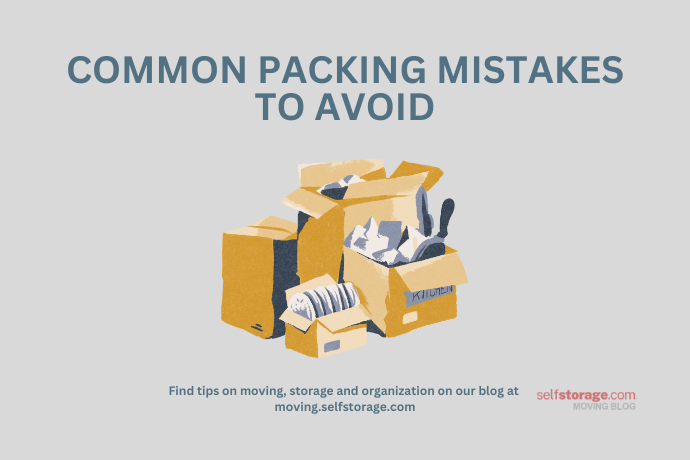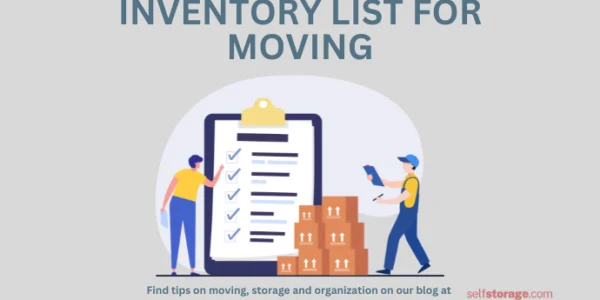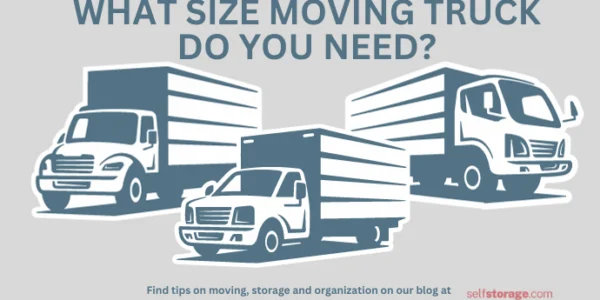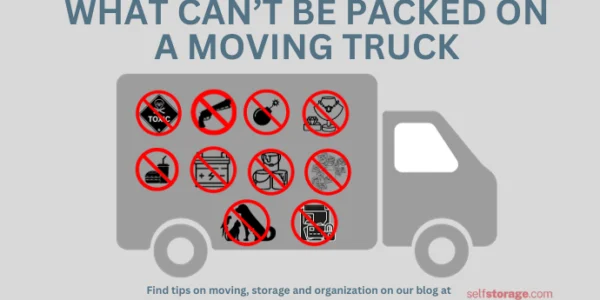Click on a link to learn more about that common packing mistake:
- Didn’t Plan Ahead
- Didn’t Create a Moving Inventory
- Packed Fragile Items Incorrectly
- Didn’t Have The Correct Packing and Moving Supplies
- Didn’t Pack Efficiently
- Didn’t Label the Boxes
- Didn’t Pack a Moving Essentials Box
- Packed non-allowable Items
- Didn’t Pack the Moving Truck Correctly
- Didn’t Ask for Help
You’re in your living room, and it’s like a scene from one of those home makeover shows — except it’s real life, and it’s your stuff everywhere. The moving truck’s coming tomorrow, and you’re standing there, hit by the reality of how much you own. And yep, it’s already past your bedtime.
Don’t worry, though. It doesn’t matter if you’re new to this whole moving thing or if you’ve moved so many times you could do it in your sleep. We all mess up sometimes, especially when it comes to packing. Waiting until the last second, mixing up what’s in which box, these little mistakes can add a whole lot of stress to what should be an exciting time. We got a hold of the 10 most common packing mistakes and untangled how you can steer clear of them.
1. Didn’t Plan Ahead
Hey, we’ve all been there — leaving packing to the last minute and then rushing through it. Not fun, right? To avoid that mess, why not start planning your packing a few weeks early? Set yourself some daily or weekly goals, and don’t forget to give yourself a little extra time for those just-in-case moments. Check out or
Wondering how long it’ll take to pack up your place? Check out our handy tips for creating a packing plan. Oh, and a heads-up: don’t forget about your garage, attic or basement. These spots can take longer to pack because there’s usually a lot of stuff tucked away in there. Our expert advice: Add an extra day for each of these areas.
2. Didn’t Create a Moving Inventory
If you don’t keep track of what’s being packed, this can lead to misplaced or forgotten items. The solution is to make a detailed inventory list of items as you pack. Categorize items by room for easy tracking, keep similar items together and don’t hesitate to incorporate a dash of technology in your inventory management.
Include detailed descriptions of the most important things — in case of loss, theft or damage, it will greatly help for insurance purposes. Take the opportunity and declutter before packing. Moving is an opportunity to purge unnecessary items, making the entire process more efficient and cost-effective.
Pro Tip: Pack each room one at a time to help keep your moving inventory organized. Not sure where to start packing? Check out our handy guide that covers what to pack first when moving.
3. Packed Fragile Items Incorrectly
Improper packing of delicate items can lead to damage during transit, either because they bump against each other in the box or truck, or because the boxes that contain them are dropped or handled roughly.
You can dodge these bullets by using the right materials — like bubble wrap, foam sheets and packing peanuts — and the right packing techniques: wrapping each fragile item individually, followed by layering and nestling similar items with padding in between. It doesn’t hurt to also label the boxes as “Fragile” or “Handle with care” on all sides.
4. Didn’t Have Enough or Correct Packing and Moving Supplies
If you run out of packing materials, you either lose a few hours to get more supplies from the store, or you end up using too little protection for your items. Whether it’s that or the fact that your packing supplies are not the right ones, this can seriously compromise the safety of your belongings.
The trick is to estimate how many boxes, packing peanuts and tape rolls you will need and then purchase more than you think necessary. Don’t forget about bubble wrap, specialty containers, packing paper, moving blankets, mattress bags and permanent markers for labeling. Better yet, take a look at our handy packing and moving supply checklist.
Plastic bags are prone to breaking and offer no protection. They can shift and tear during transit, spilling contents. Use boxes instead for safety and stability but be cautious with using old boxes as they may break or crumple. New moving boxes are more durable, uniform in size and better for stacking.
Also, make sure you get strong and sturdy packing tape for sealing boxes, with shipping tape for heavier packaging, and stay clear of scotch tape, this is not a job for it.
5. Didn’t Pack Efficiently
As I mentioned when talking about the moving inventory, it is best to pack items by room and usage. Use small boxes for heavy items like books and, in mixed boxes, place heavier items at the bottom and lighter items on top.
Avoid overloading boxes. This makes them unstable and can break or cause injury. As a rule of thumb, keep boxes under 50 pounds and check if they are easy to carry by lifting them before sealing.
It’s equally important not to under-pack. Fill empty spaces in boxes with towels, blankets or balled-up paper for cushioning and maintaining box integrity.
6. Didn’t Label the Boxes
Unlabeled boxes can cause confusion during unpacking and difficulty in finding items. Besides labeling each box with its contents, also add the room it belongs to and consider color-coding for additional efficiency.
Use a black wide tip marker and make those labels 2 inches high on two sides and the top of each box. Number each box and keep a cross-referenced list in your inventory for easy tracking. Got any special instructions for the movers like “keep upright” or “top load only”? Mark them on all four sides of the box.
7. Didn’t Pack a Moving Essentials Box
Ever heard of an “open-first box“? Packed with the essentials you’ll need during those first few days in a new place, it’s your quick access to familiarity amid the chaos of unpacking.
Make sure this box stands out with clear, large labels and keep it within easy reach during the move. If it has to go in the truck, pack it last so you can get to it first.
What goes in this magic box? Toiletries like toothbrushes and soap, medications, important documents, a change of clothes and basic kitchen items like a few utensils, cups, snacks and coffee.
8. Packed non-allowable Items
When packing for a move, you should be mindful of items that are hazardous or not allowed by movers. The best thing you can do is check with the moving company for a list of prohibited items in advance. Properly dispose of or transport separately things that aren’t allowed in the moving truck. Here’s what generally doesn’t make the cut:
- Hazardous materials like explosives, flammables, chemicals and batteries.
- Food and perishables, as they can attract pests or cause spills.
- Houseplants and pets, because they need special care that moving trucks can’t provide.
- Valuables and important documents — these are best kept close to you.
- Prescriptions and medical equipment — these should go in your essentials box.
Transporting firearms and ammunition is complicated and your best bet is to reach out to a licensed firearms dealer to ensure compliance.
9. Didn’t Pack the Moving Truck Correctly
Packing a moving truck improperly can lead to damage and inefficient use of space. To make sure this doesn’t happen, first off, get to know the truck’s dimensions and capacity — this helps you plan the layout and avoid overloading.
Next, pay attention to weight distribution. Load large furniture and appliances at the front (near the driver’s cabin) and along the walls. This anchors your load for stability. Secure everything with high-quality straps that attach to the truck’s anchor points and consider moving blankets — they are great for protecting furniture from damage.
Last but not least, make the most of vertical space by stacking boxes snugly to minimize gaps: heavy boxes go on the bottom, and lighter and fragile items on top.
10. Didn’t Ask for Help
Packing and moving are bigger jobs than most of us expect, and they can really take their toll. Why not call in some backup? Rally your friends or family to help out. They can be superstars at sorting, carefully wrapping and boxing up your stuff.
Hand out specific tasks to keep things organized — someone tackles the books and another takes on the fragile items, while you get those boxes assembled and labeled. And hey, for the really heavy stuff or those priceless treasures, it might be worth getting some pros involved. Trust me, your back (and sanity) will thank you later!
Common Packing Mistakes Averted
Whether it’s mapping out your packing weeks in advance, keeping a hawk-eye on your inventory or making sure your truck is packed just right — it’s these little steps that smooth out the road to your new place.
And hey, don’t forget the essentials! That life-saving box of must-haves, steering clear of items that movers won’t touch and rallying your crew (or some moving pros) when things get too heavy.
With the above 10 packing mistakes out of the way, you’re totally ready to rock this move.





